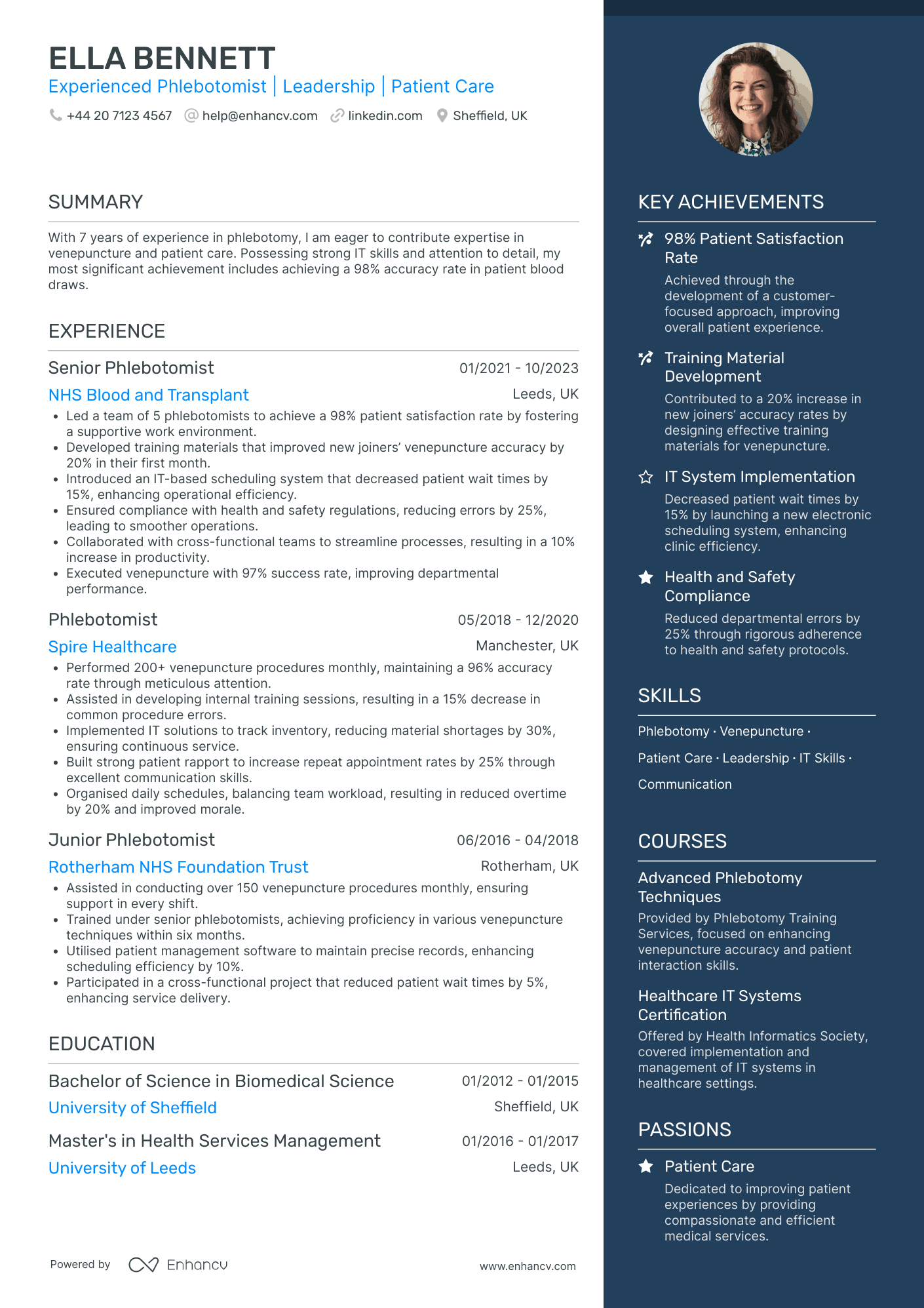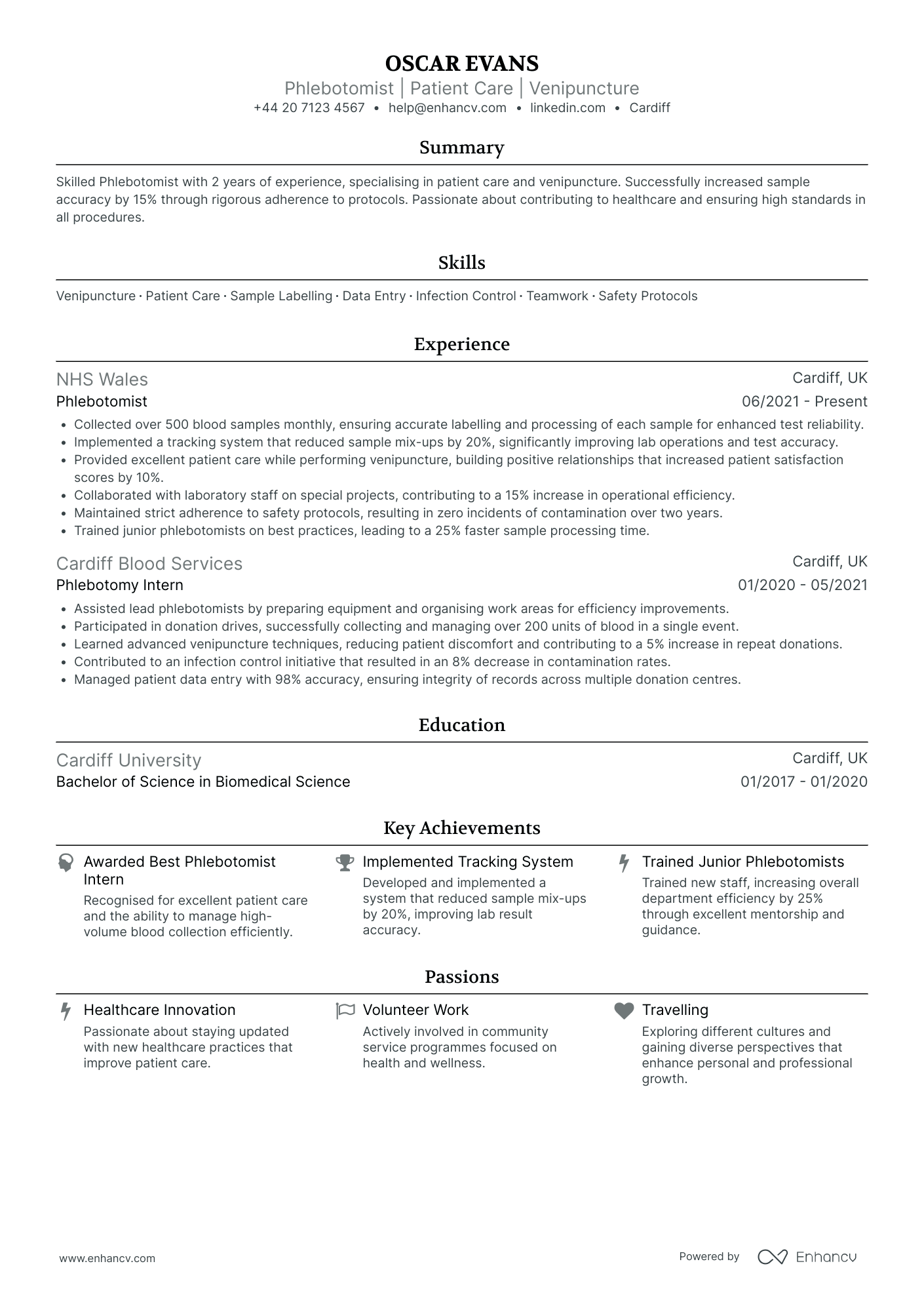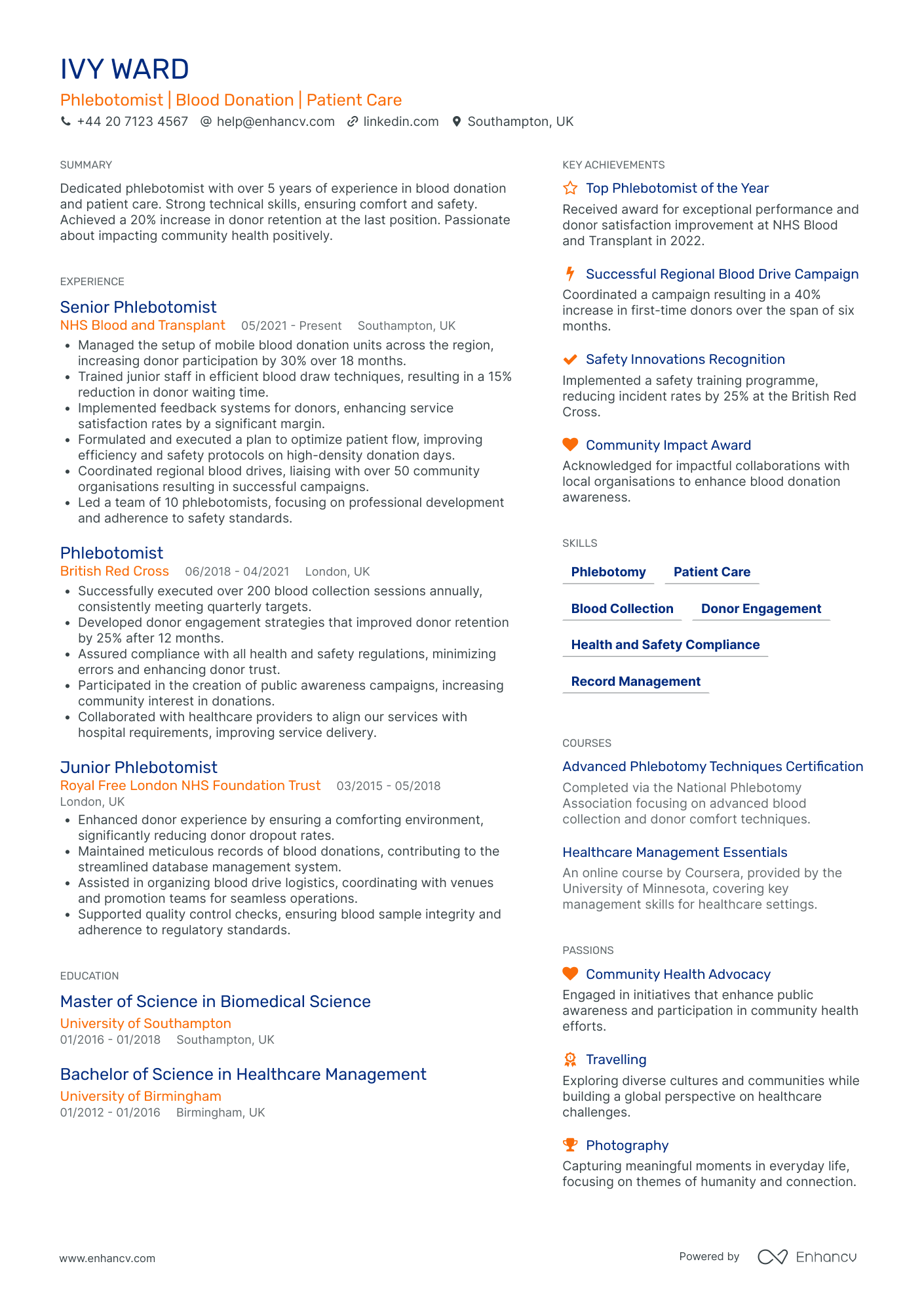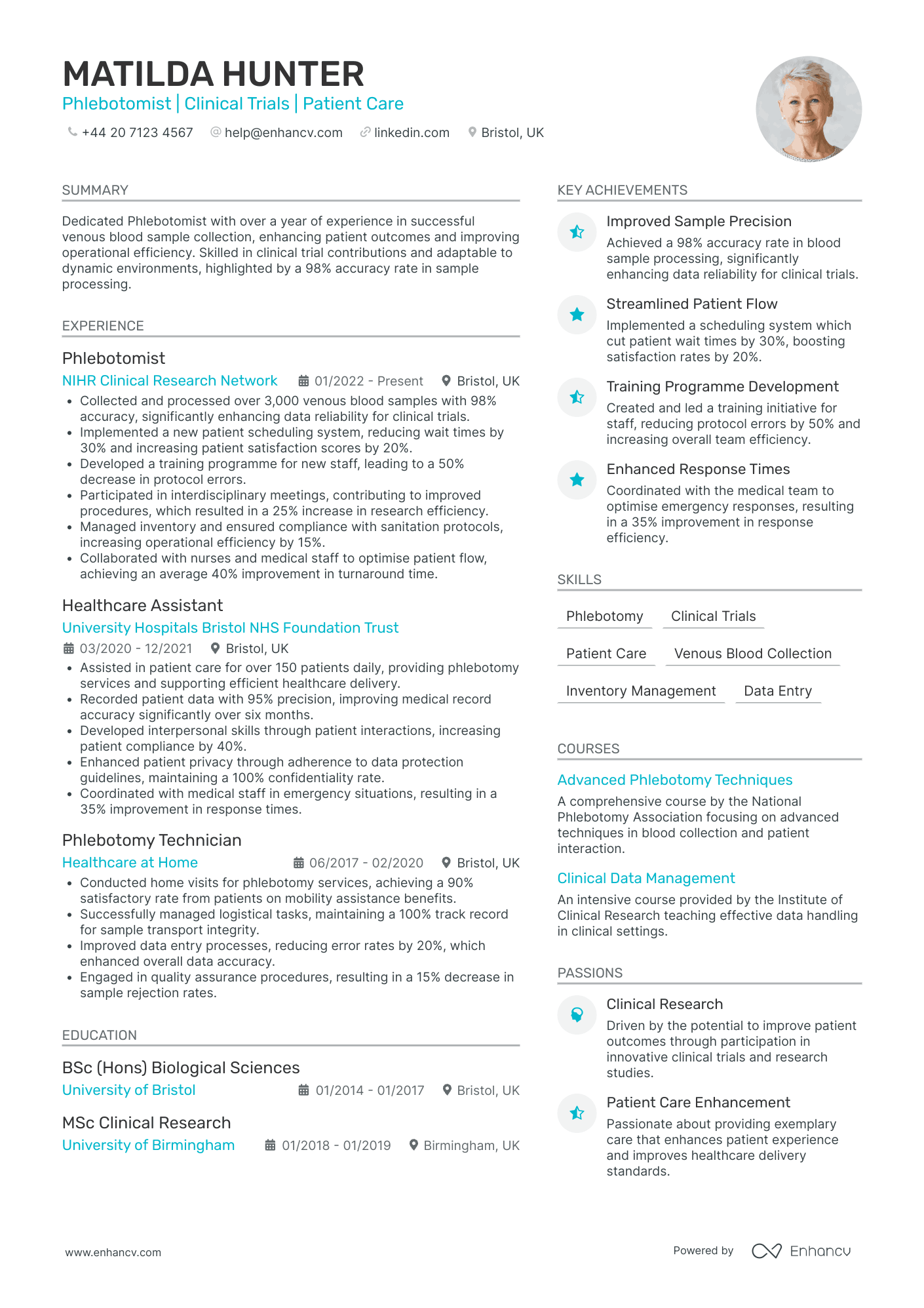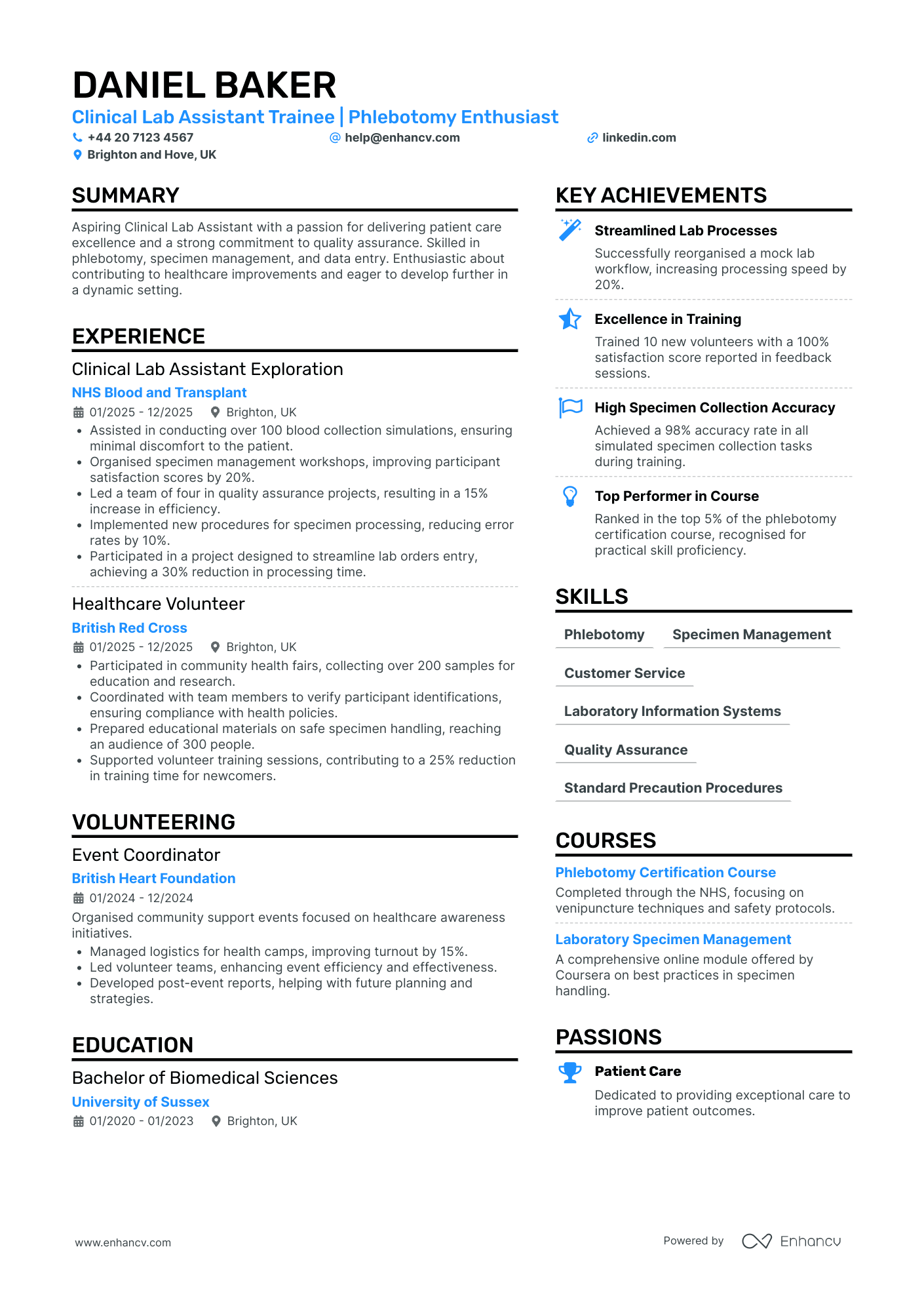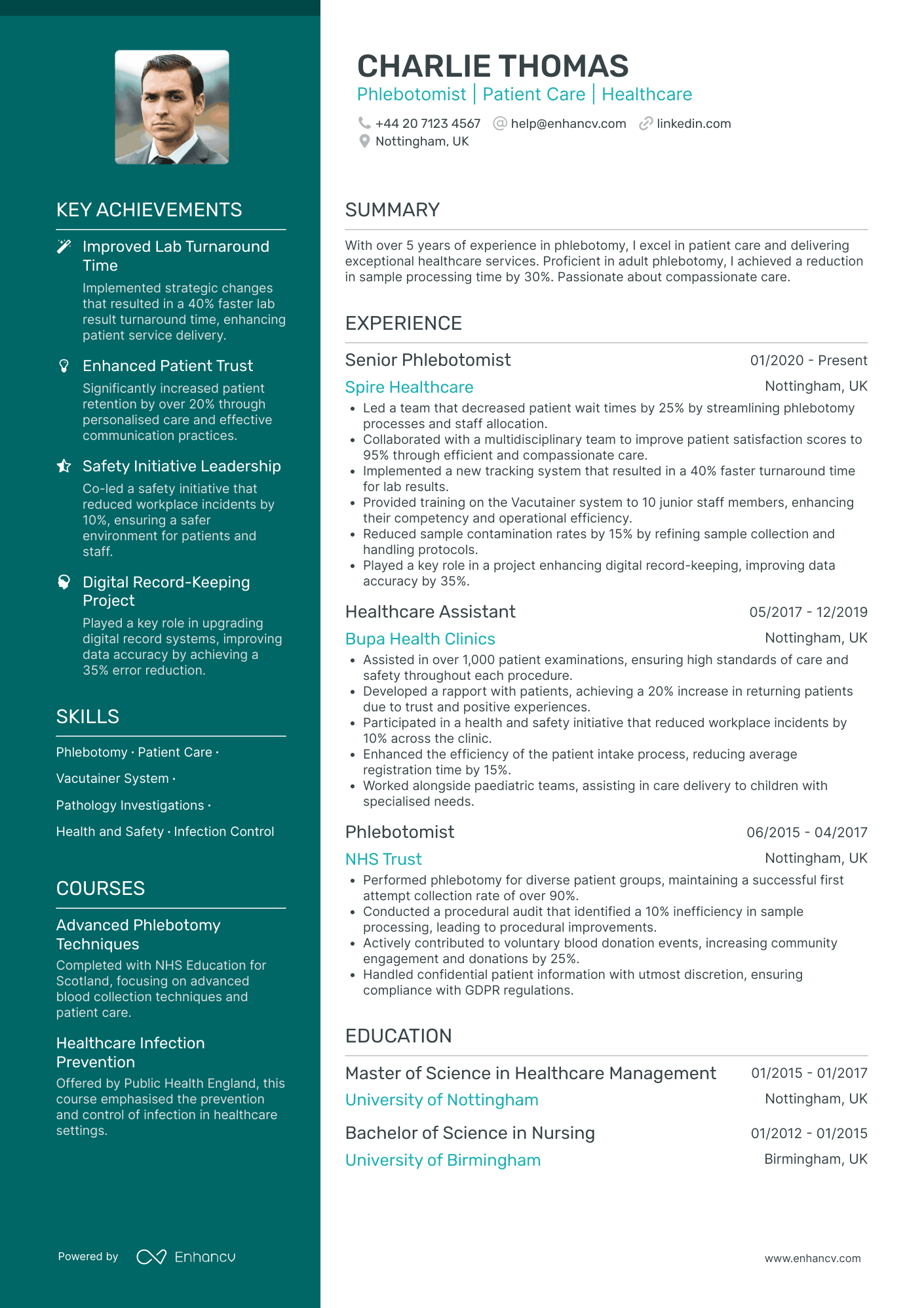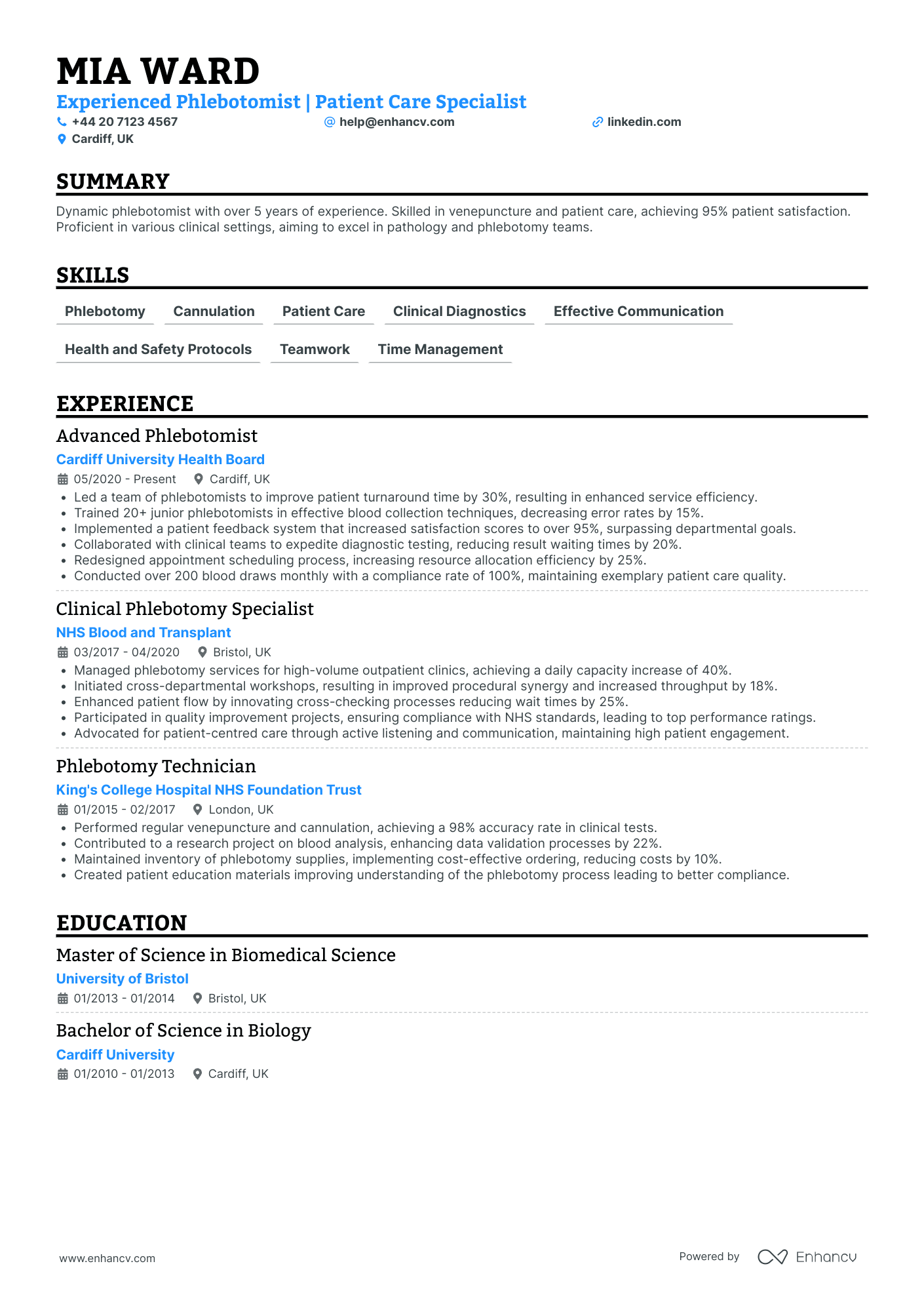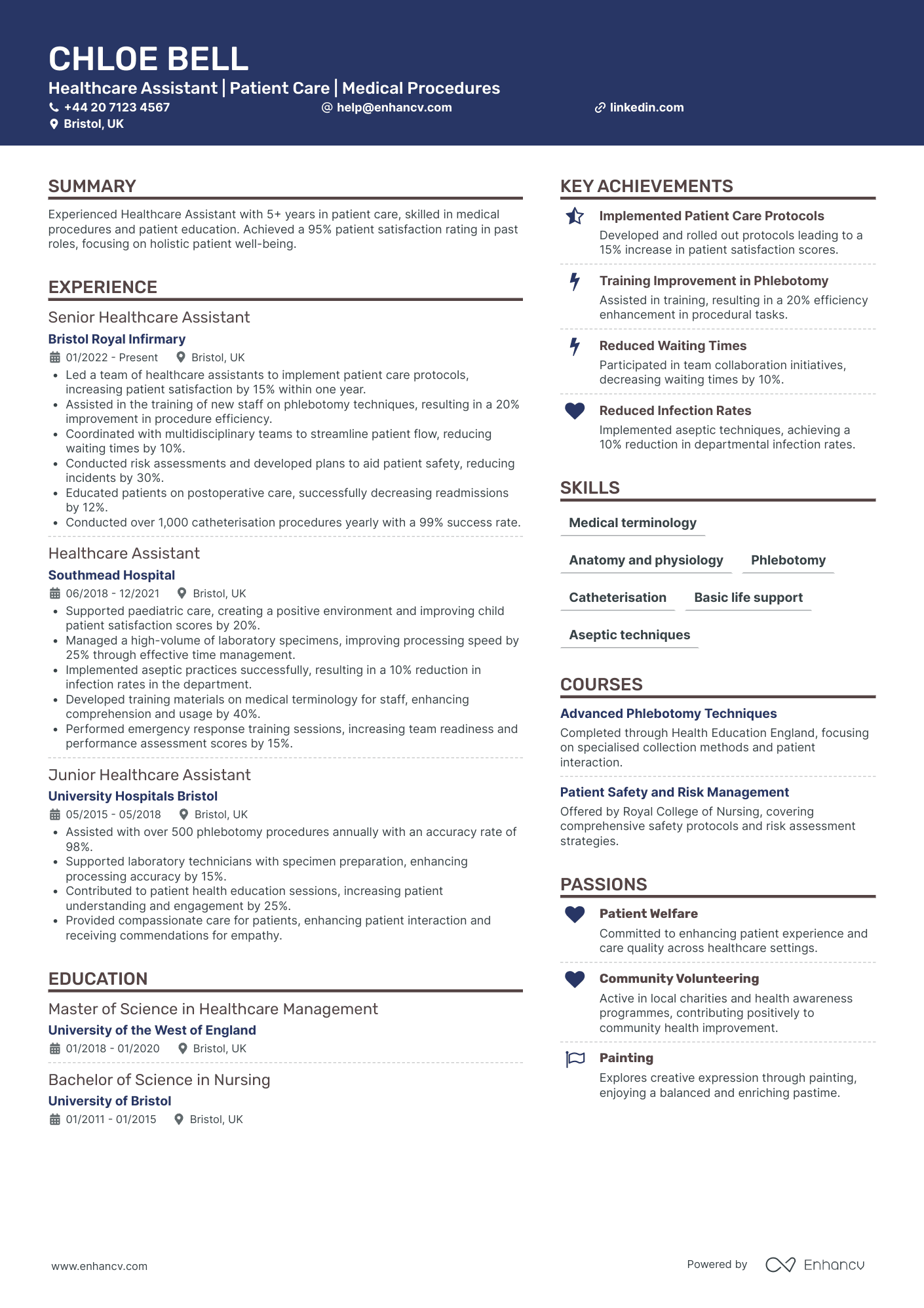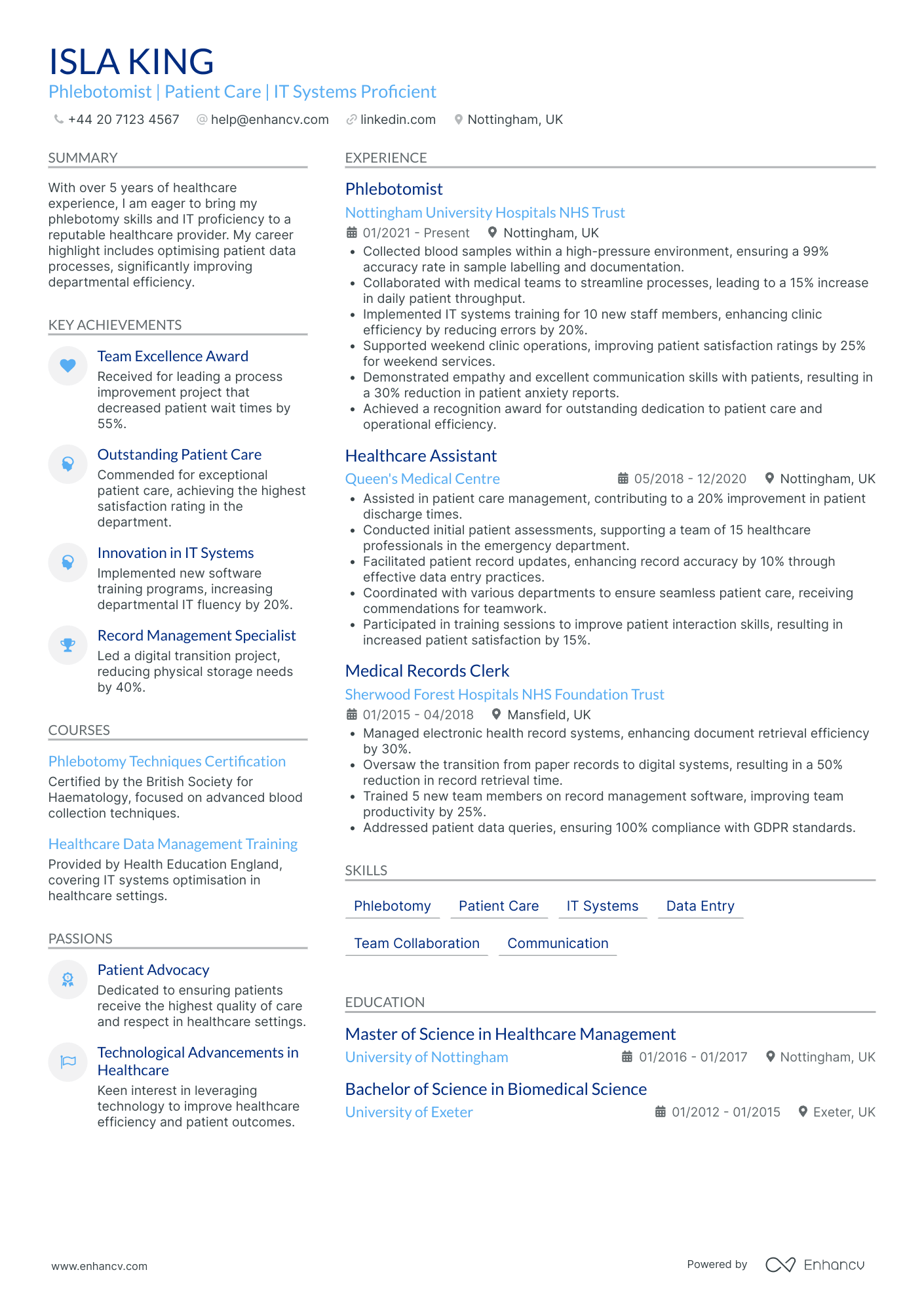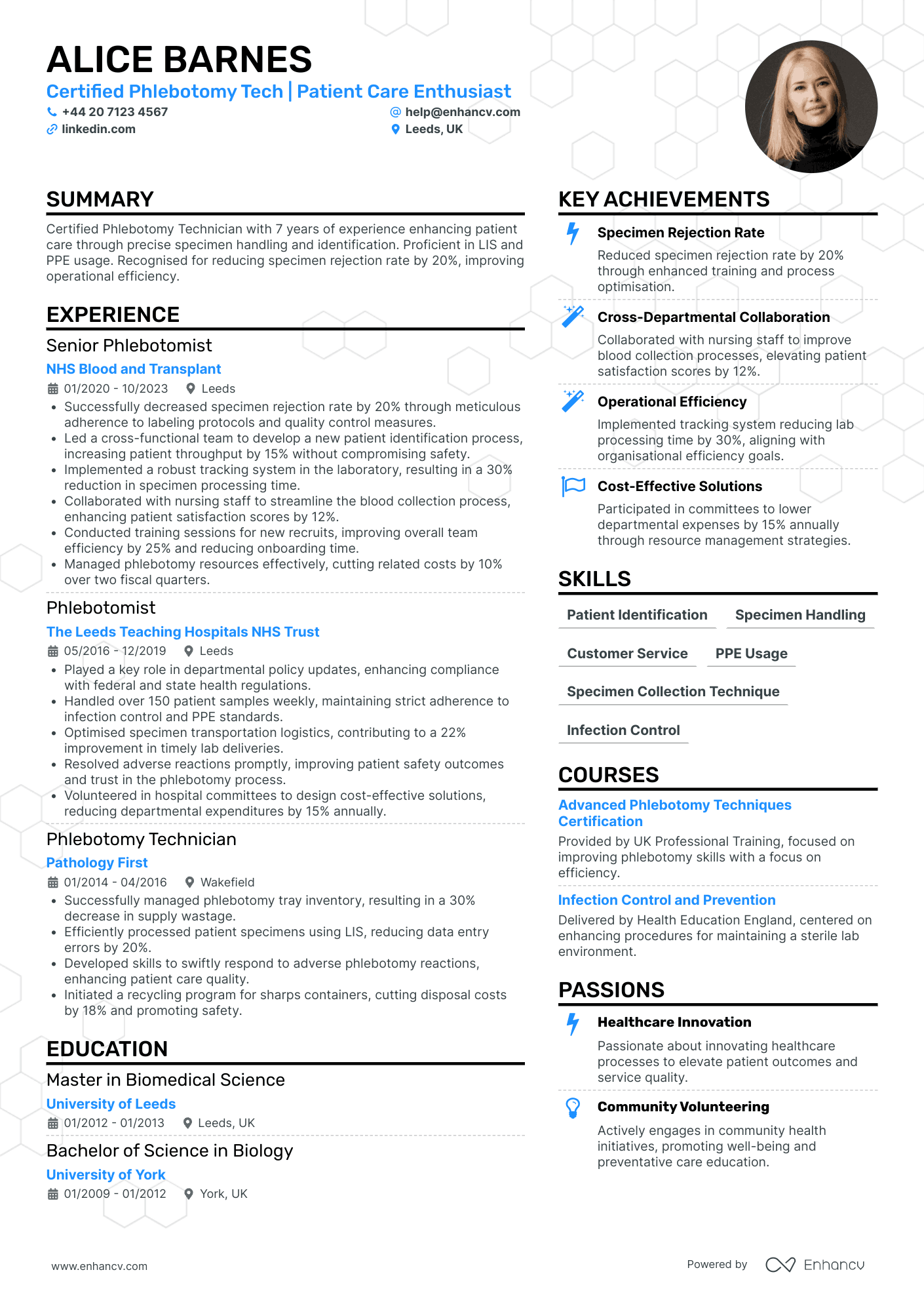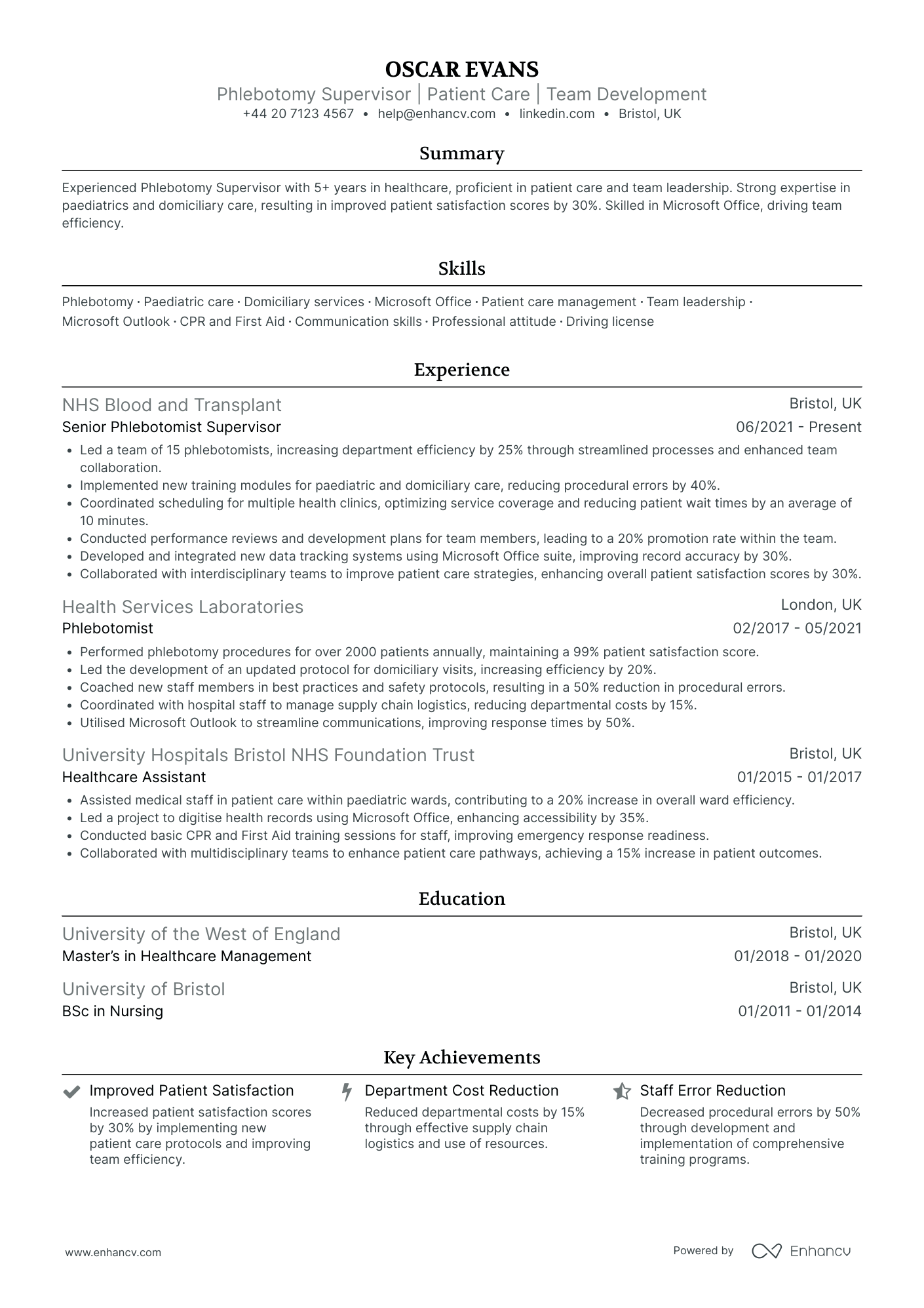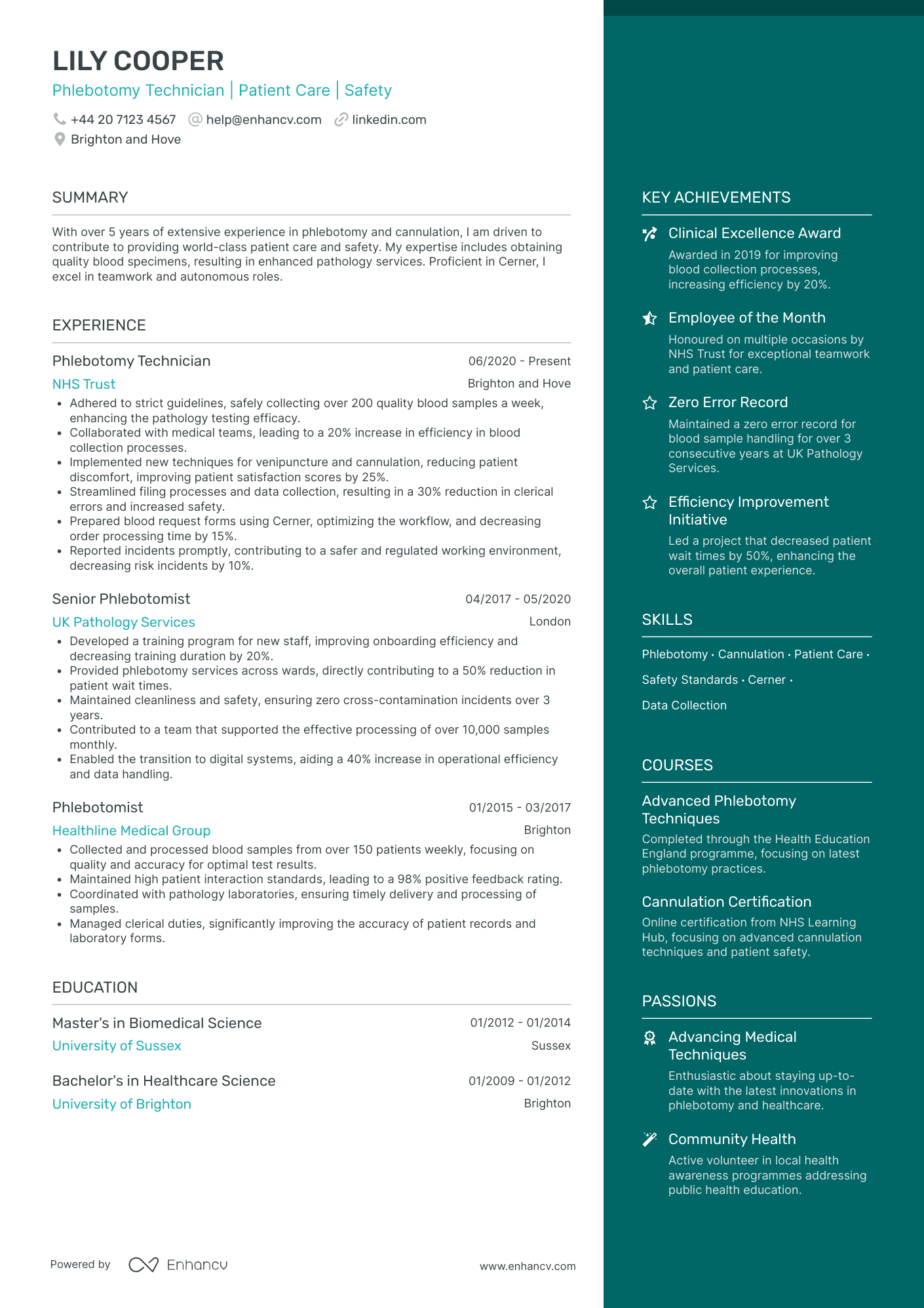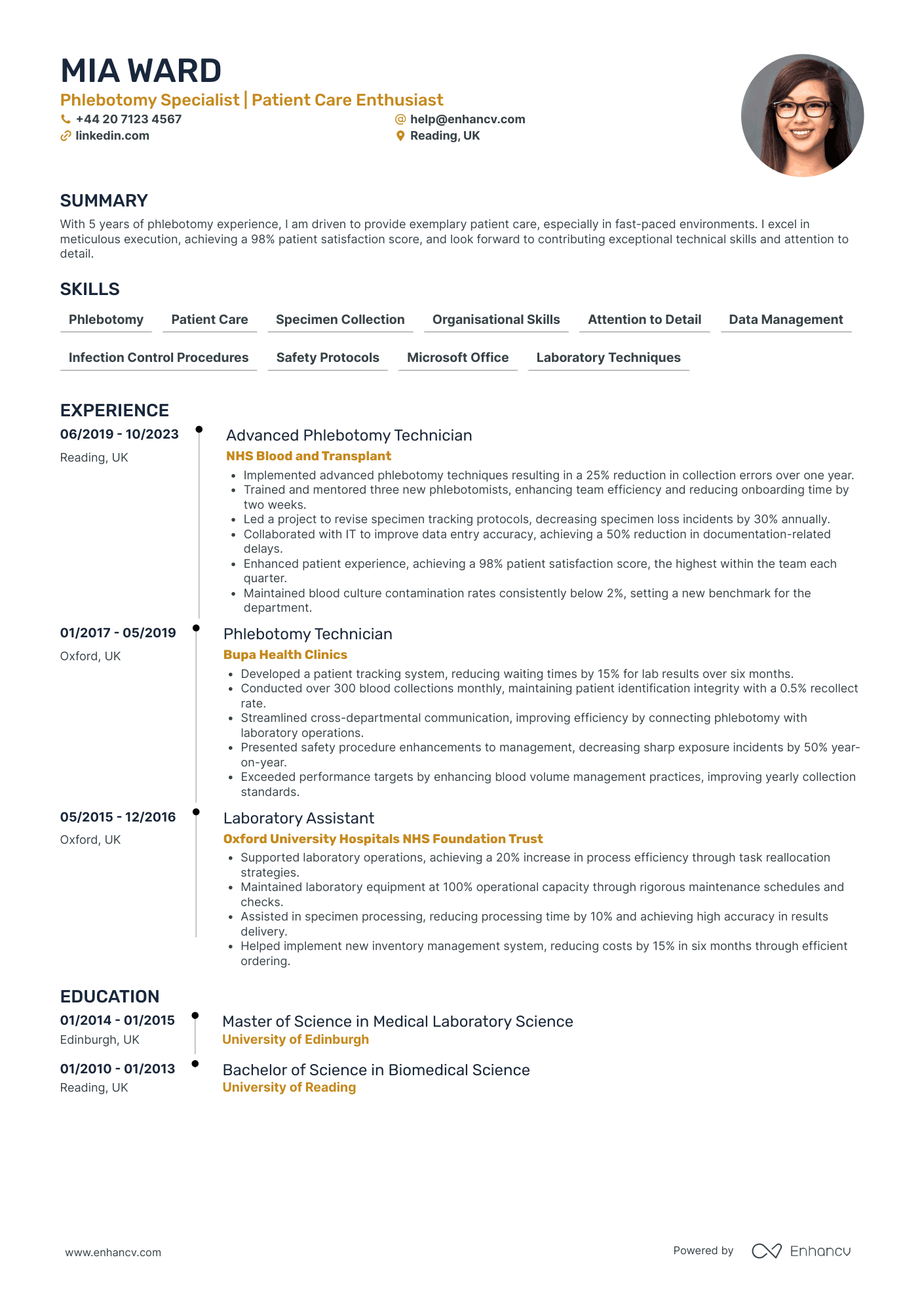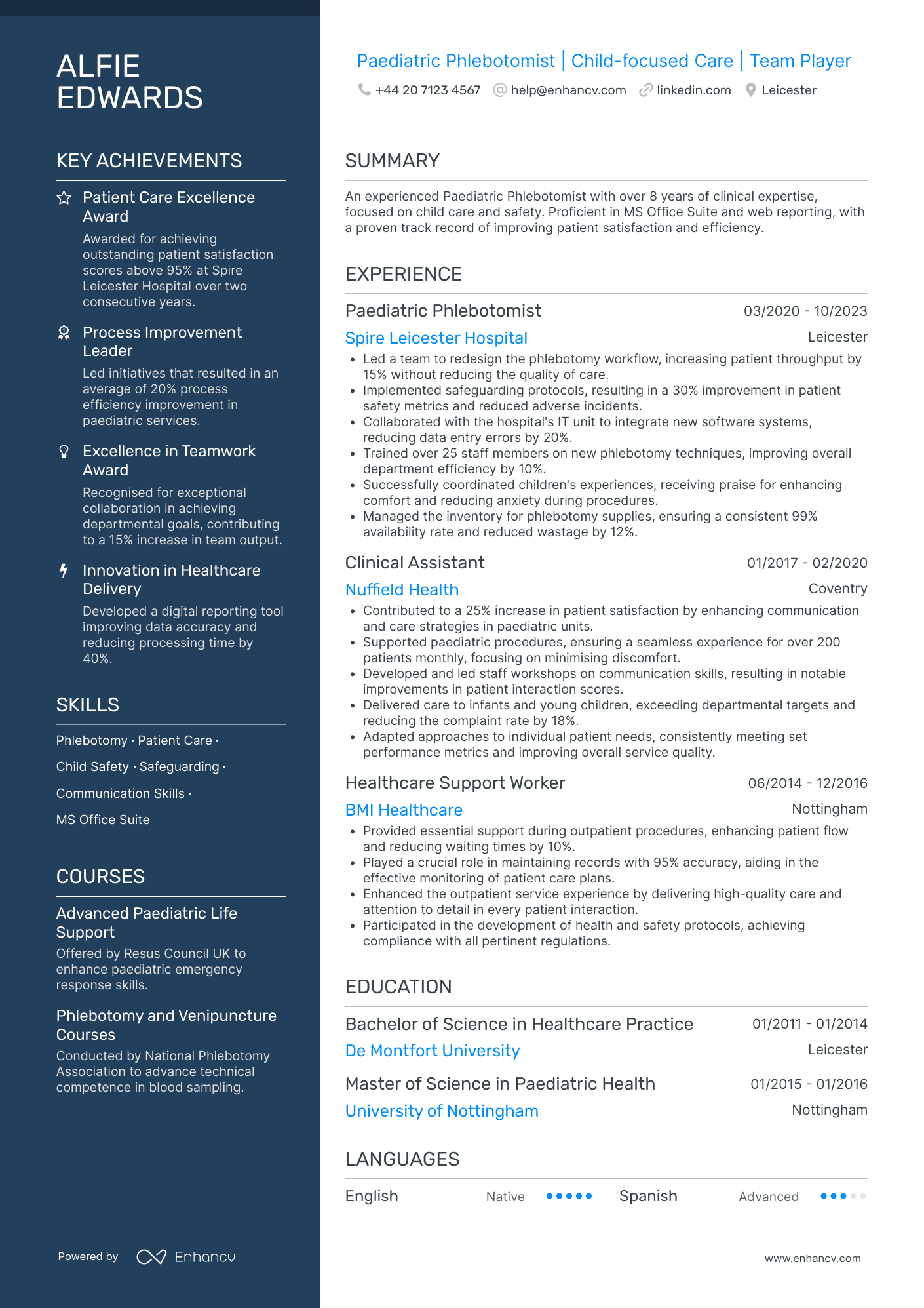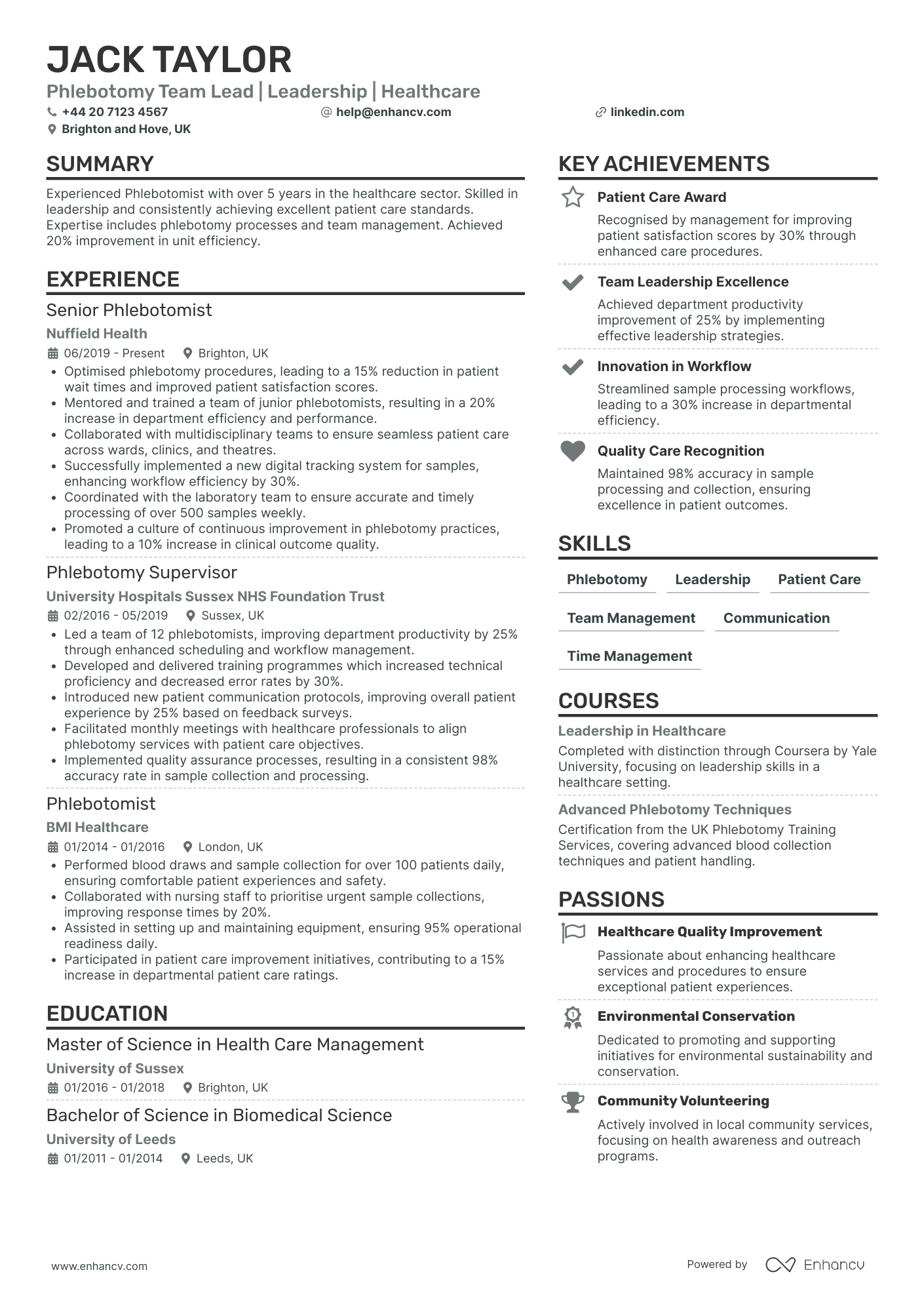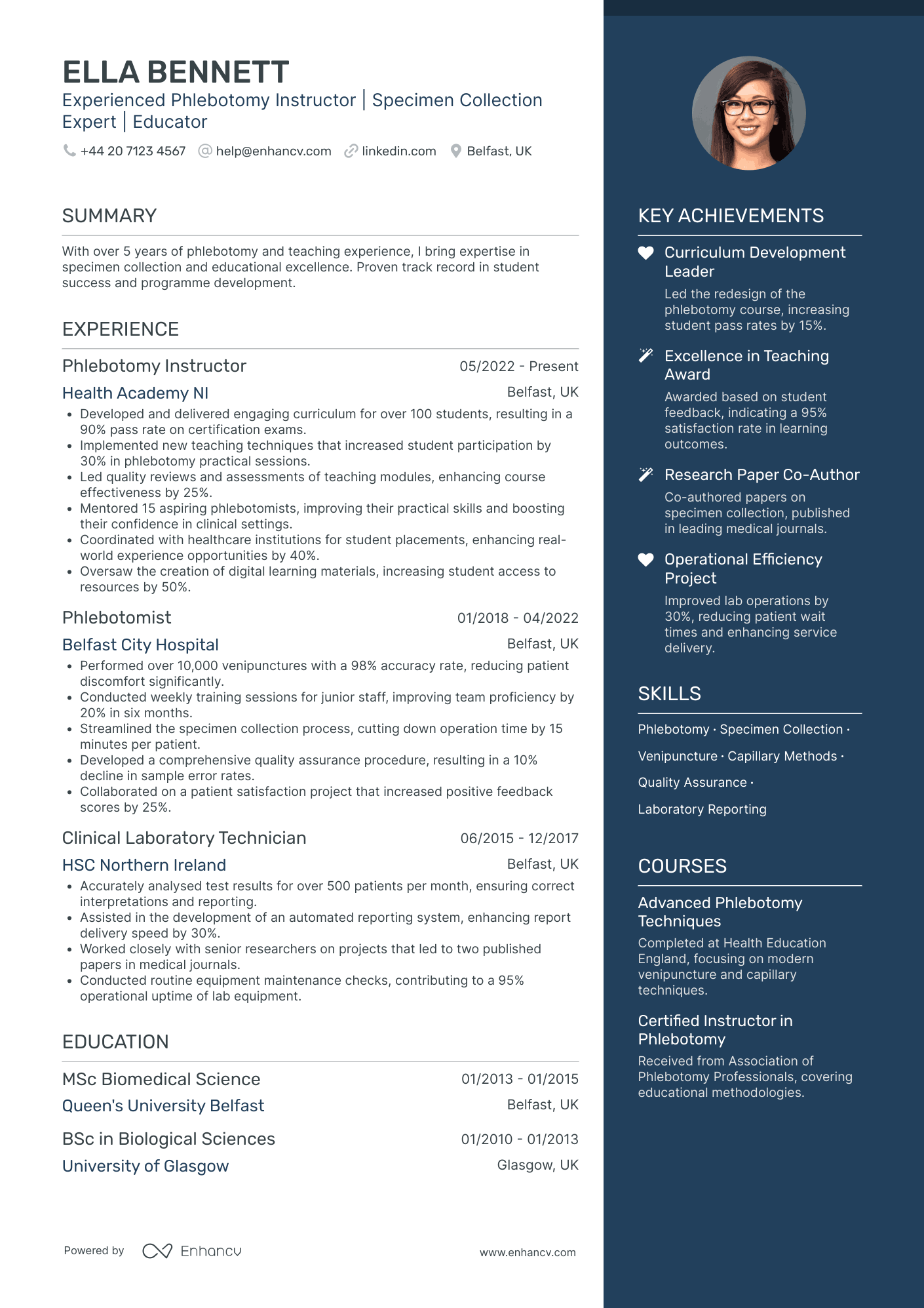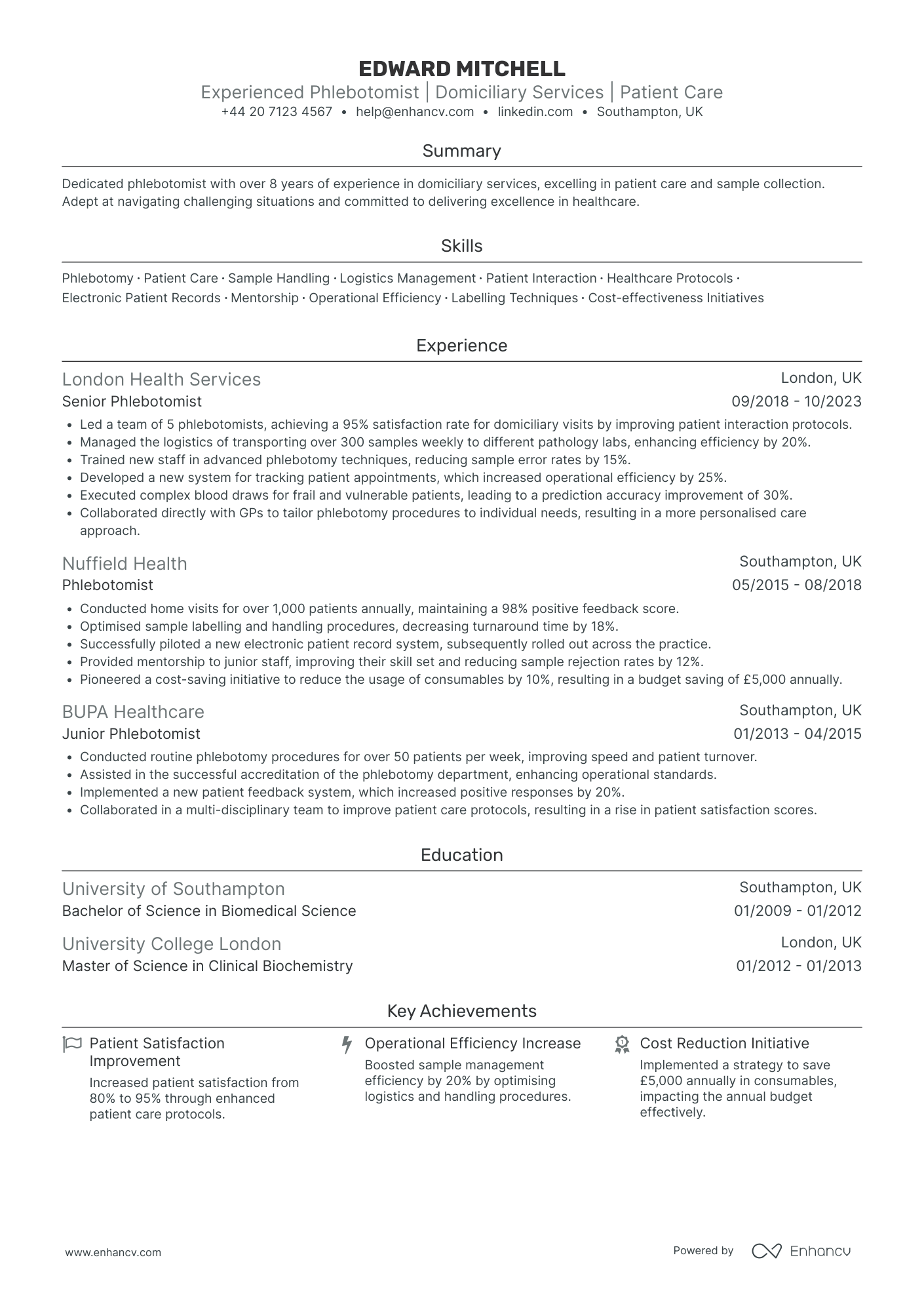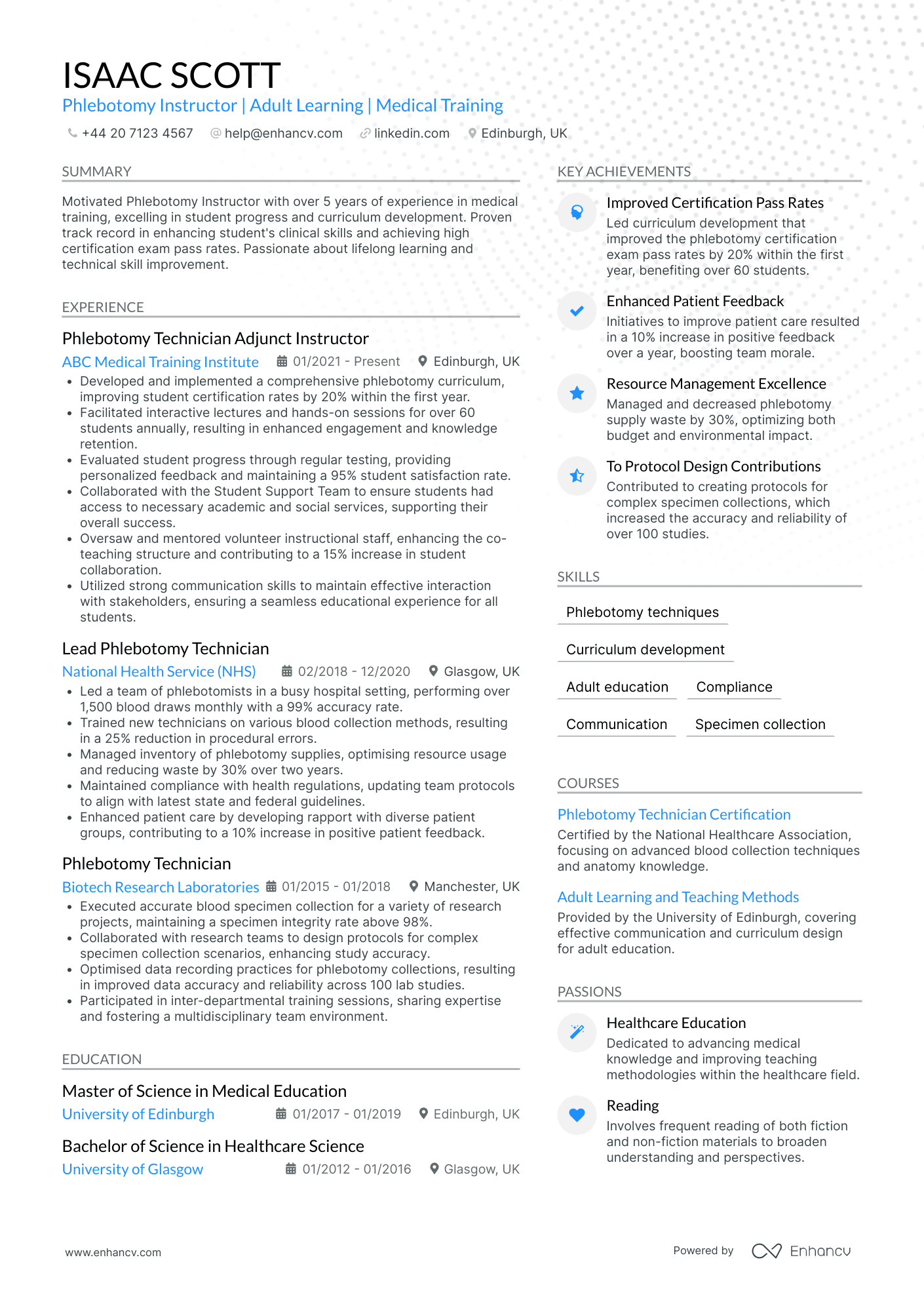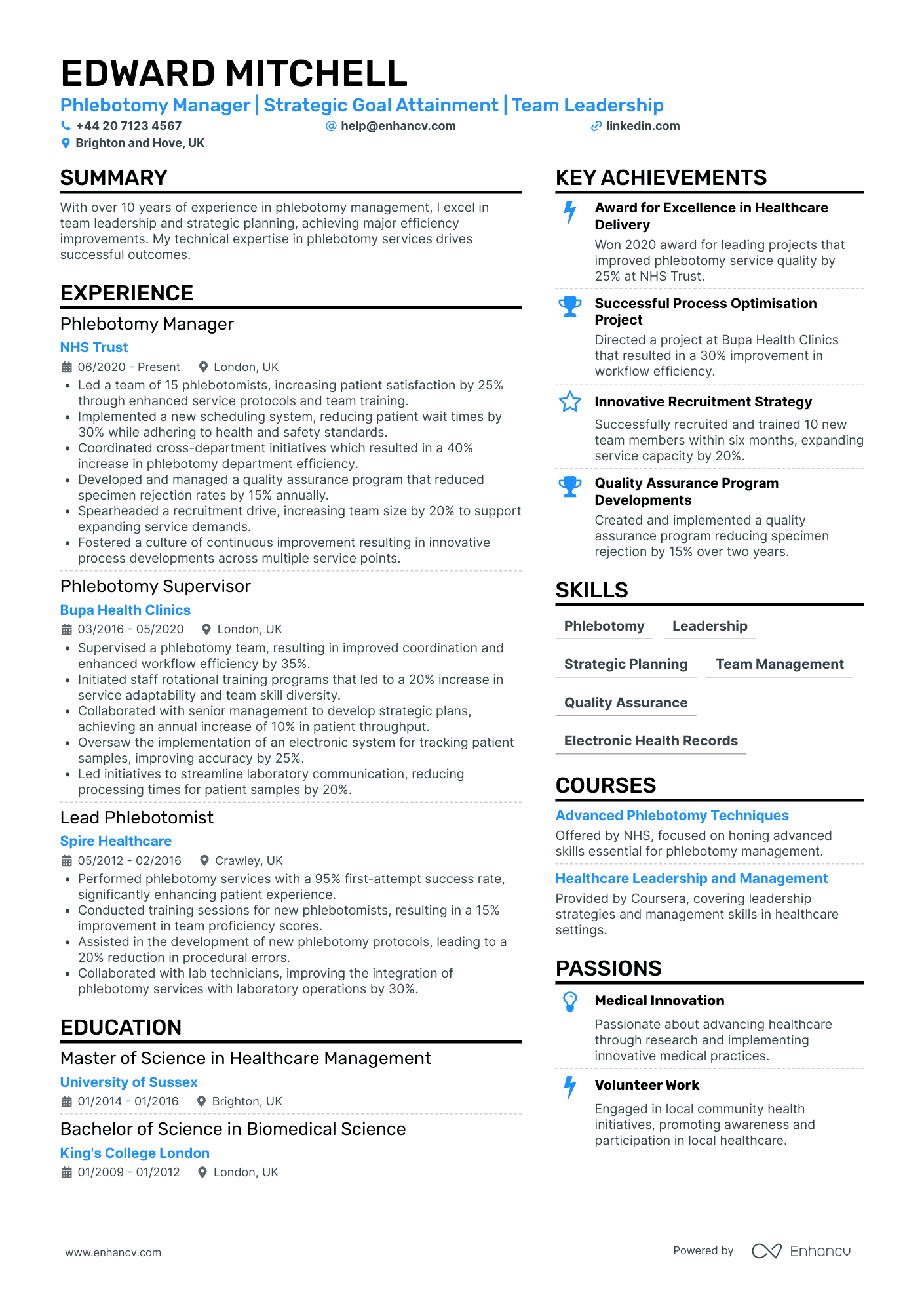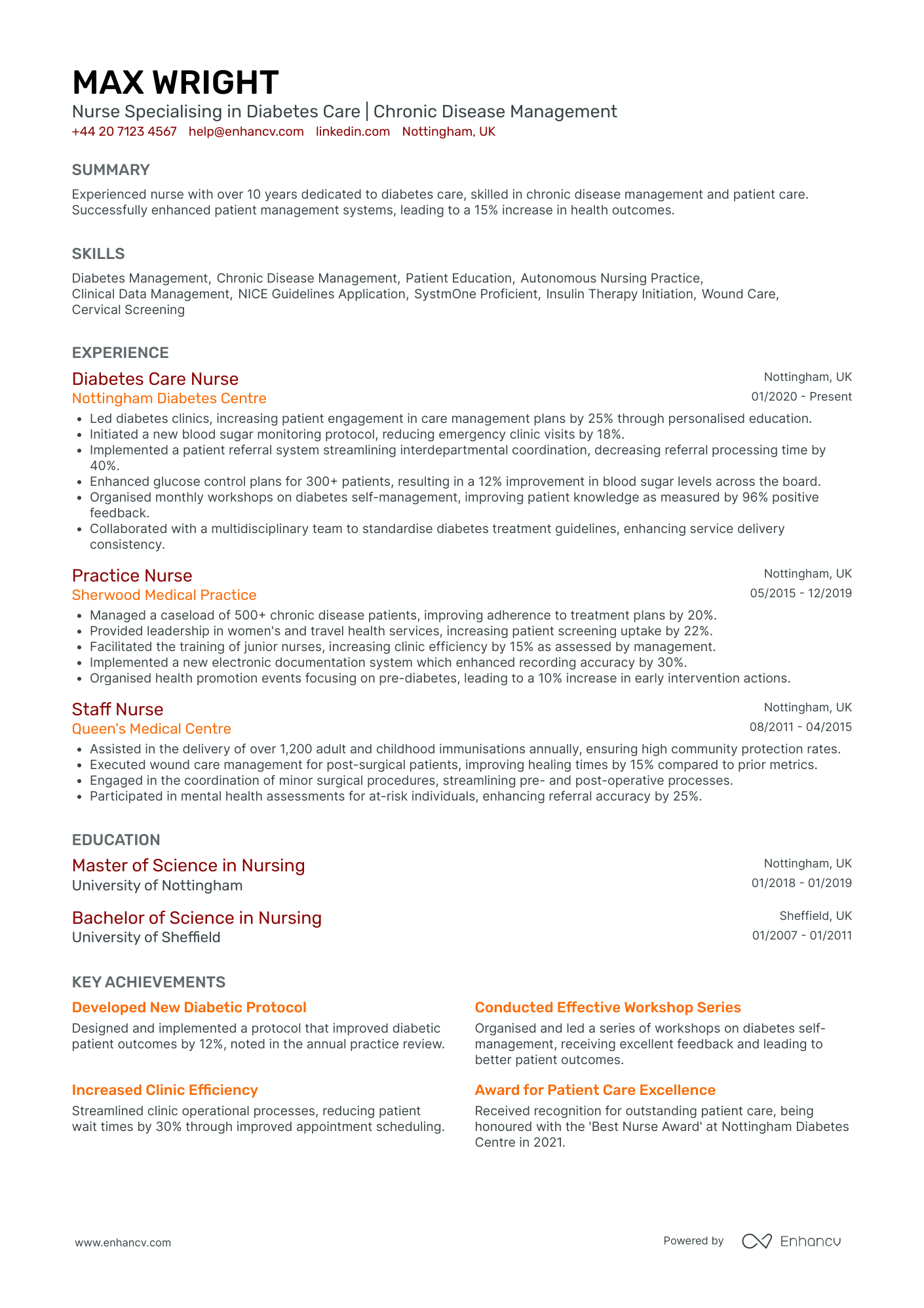One of the key CV challenges faced by phlebotomists is effectively showcasing their technical skills and experience in blood collection in a manner that stands out to potential employers. Our guide offers targeted advice and examples on how to concisely articulate these competencies, ensuring your application captures the attention of healthcare recruiters.
- Applying best practices from real-world examples to ensure your profile always meets recruiters' expectations;
- What to include in your work experience section, apart from your past roles and responsibilities?
- Why are both hard and soft skills important for your application?
- How do you need to format your CV to pass the Applicant Tracker Software (ATS) assessment?
If you're writing your CV for a niche phlebotomist role, make sure to get some inspiration from professionals:
Resume examples for phlebotomist
By Experience
Senior Phlebotomist
- Clear and Structured Content Presentation - Ella Bennett's CV is meticulously organized with distinct sections that facilitate a seamless reading experience. The use of bullet points across her experience sections ensures clarity and conciseness, allowing key achievements and responsibilities to be quickly understood without excessive detail. This structured presentation enhances her professional narrative by clearly delineating her career progress and successes.
- Progressive Career Trajectory - Ella’s career path showcases an impressive trajectory, beginning as a Junior Phlebotomist and advancing to a Senior Phlebotomist, indicating her capability for growth and increased responsibility. This progression reflects her expanding expertise and her capacity to take on leadership roles, making her an attractive candidate for positions requiring both experience and the potential for advancement in phlebotomy and healthcare management.
- Technical Depth and Industry-Specific Tools - The CV highlights Ella’s proficiency with industry-specific tools and IT systems, which are critical in modern healthcare environments. Her experience with introducing an IT-based scheduling system and inventory tracking stands out as it demonstrates her technical acumen and ability to contribute to operational efficiency, vital for roles focused on streamlining healthcare processes.
Junior Phlebotomist
- Structured progression and specialization - Oscar Evans' career trajectory reflects a clear progression within the phlebotomy field, beginning with an internship and advancing to a full-time position as a phlebotomist with NHS Wales. The transition shows growth and an increasing level of responsibility, focusing on patient care and operational efficiency.
- Integration of technical skill sets specific to phlebotomy - The CV underscores specific phlebotomy-related techniques and technologies, such as venipuncture, infection control, and implementing a tracking system for samples. This technical depth highlights Evans’ ability to improve procedural accuracy and patient care, which is crucial in a healthcare setting.
- Achievement-driven impact on healthcare operations - Each role is accompanied by quantifiable achievements that demonstrate a significant impact on healthcare delivery. Examples such as improving sample processing times by 25% and increasing patient satisfaction scores by 10% illustrate Evans' ability to effect positive change in operational efficiency and patient relations.
Entry-Level Phlebotomist
- Clear and Strategic Presentation - Ivy Ward's CV effectively utilizes a structured and concise format, allowing her accomplishments and skills to be easily understood. The document is well-organized, with distinct sections that include career experience, education, and achievements, all geared towards her expertise in phlebotomy and patient care.
- Progressive Career Growth - The CV reflects a clear trajectory of growth, from Junior Phlebotomist to Senior Phlebotomist. Ivy's career progression within reputable organizations such as NHS Blood and Transplant and the British Red Cross highlights her professional development and increased responsibilities over time, showcasing her dedication to the field.
- Significant Community and Business Impact - Ivy's achievements are particularly noteworthy for their strong impact on business and community health. Her role in boosting donor retention and participation significantly contributes to the organizations' objectives, demonstrating her ability to implement strategic initiatives that culminate in marked improvements in service delivery and community engagement.
Experienced Phlebotomist
- Strong Career Trajectory with Clear Growth - Matilda's career demonstrates upward mobility and skill development, evolving from a Phlebotomy Technician to a Phlebotomist position with the NIHR Clinical Research Network. Her transition into an NIHR Phlebotomist role reflects her growing expertise, along with her emphasis on clinical trials that align with her academic background in Clinical Research.
- Effective Use of Data and Metrics - The CV integrates key performance metrics and achievements effectively, providing clear evidence of her impact on operational efficiency and patient care. For instance, a 98% accuracy rate in sample processing and a 30% reduction in wait times are directly linked to improved patient satisfaction and research efficiency.
- Adaptability and Cross-Functional Collaboration - Matilda's various roles across different healthcare settings require adaptability and the capability to work in multidisciplinary teams. Her collaboration with nurses, physicians, and stakeholders to streamline procedures showcases her ability to function effectively within various professional environments and improves clinical outcomes.
Phlebotomist Intern
- Effective Use of Leadership in Projects - Throughout the experience section, Daniel Baker's CV highlights his leadership abilities, such as leading a team of four in quality assurance projects to increase efficiency by 15%. This demonstrates his capacity to manage and motivate a team, a critical attribute for advancing in clinical lab settings.
- Integration of Educational Background - The CV ties Daniel's academic achievements in Biomedical Sciences with his professional experiences, showcasing a seamless transition from education to a specialized career. This highlights his ongoing commitment to the field and readiness to apply theoretical knowledge to practical tasks.
- Impactful Volunteer Experiences - Daniel's CV details his volunteering roles with the British Red Cross and British Heart Foundation, which underscore his dedication to community health and provide evidence of his capacity to organize and lead public health initiatives, a valuable trait for any health-related role.
Part-Time Phlebotomist
- Impressive Career Advancement - Charlie Thomas’ CV illustrates a clear and steady career progression from Phlebotomist to Senior Phlebotomist, which reflects growth and expertise in the field. Notably, Charlie developed from handling basic phlebotomy duties to leading a team and implementing process improvements at Spire Healthcare, demonstrating their increasing responsibility and leadership capability in healthcare settings.
- Implementation of Innovative Healthcare Solutions - The CV highlights unique industry-specific elements where Charlie has contributed to improving healthcare processes. By implementing a new tracking system to enhance lab result turnaround times and refining sample collection protocols, Charlie showcases their skills in applying technical and methodical frameworks to solve practical challenges in medical environments.
- Commitment to Patient-Centric Care and Efficiency - Through achievements like enhancing patient trust and satisfaction scores, reducing wait times, and improving data accuracy, the CV effectively portrays Charlie’s dedication to patient care. The initiatives taken not only demonstrate strong soft skills and leadership but also highlight significant impacts on operational efficiency and patient loyalty.
Full-Time Phlebotomist
- Content Presentation - Mia Ward's CV showcases impressive clarity and structure. It is well-organized, beginning with a succinct summary of her experience and skills. Each section is distinct and clearly marked, allowing easy navigation and comprehension. The use of bullet points in the experience section enhances readability, making it easy to quickly glean the core responsibilities and achievements of each position.
- Career Trajectory - Mia's progression demonstrates significant growth within the phlebotomy field. She has steadily advanced from a Phlebotomy Technician to an Advanced Phlebotomist role, assuming greater responsibilities and leadership positions. Her transition from different institutions such as King's College Hospital NHS Foundation Trust to NHS Blood and Transplant, and ultimately to Cardiff University Health Board, portrays her ability to thrive and excel within various healthcare environments.
- Soft Skills and Leadership - The CV emphasizes Mia’s strong leadership and interpersonal skills, which are crucial in healthcare settings. She has led a team to improve operational efficiency and trained numerous junior phlebotomists, highlighting her role as a mentor. Her commitment to patient satisfaction and effective patient communication also demonstrates substantial soft skill proficiency, essential for providing exceptional patient care.
Temporary Phlebotomist
- Comprehensive and Structured Presentation - Chloe Bell's CV is well-organized, showcasing a clear structure that begins with her header information, followed by a concise summary. Each section is divided logically, guiding the reader seamlessly through her professional journey, qualifications, and achievements. This clarity ensures that potential employers can quickly access critical information.
- Evidence of Career Growth and Leadership - Chloe's career trajectory illustrates substantial professional growth. Beginning as a Junior Healthcare Assistant, she has progressed to a Senior Healthcare Assistant role, highlighting promotions that reflect her capability and leadership skills. Her experience in leading teams and developing staff showcases her ascent in the healthcare sector.
- Significant Achievements with Business Impact - The CV details Chloe's impressive accomplishments, such as implementing patient care protocols that improved satisfaction by 15% and reducing departmental infection rates by 10%. These achievements showcase not just her personal successes but also her impact on the institutions she worked for, emphasizing her ability to drive effective changes in healthcare settings.
Permanent Phlebotomist
- Content Presentation Reflecting Professionalism - The CV is clearly structured with concise headings and sections, ensuring that readers can quickly identify key areas such as experience, education, and skills. Each section is brief and focused, presenting achievements and responsibilities in bullet point format that enhances readability.
- Career Trajectory Signifying Growth - Isla King's career progression is well demonstrated through her transitions from Medical Records Clerk to Phlebotomist. Each role shows an increase in responsibility and scope, highlighting her growth within healthcare settings and her readiness for advanced roles through acquired skills and qualifications.
- Achievements with Direct Patient Impact - The achievements section effectively illustrates the direct impact Isla has had on patient care and operational efficiency. Her initiatives have led to improved patient satisfaction and reduced wait times, demonstrating a clear alignment with healthcare goals to enhance patient experiences and departmental efficiency.
By Role
Certified Phlebotomist
- Content presentation and clarity - Alice Barnes' CV offers a clear and structured presentation that emphasizes her qualifications and career progression effectively. The use of bullet points ensures that critical information, such as job responsibilities and achievements, is concise yet comprehensive, making it easy for potential employers to grasp her capabilities swiftly.
- Career trajectory showcasing growth - Alice's career progression from a Phlebotomy Technician to a Senior Phlebotomist illustrates a clear trajectory of growth and leadership development within the field. Her roles at different institutions highlight increased responsibilities, evident in her transition to leading cross-functional teams and managing resources effectively.
- Achieving impactful business results - Alice's achievements are not only quantified but also elaborated on in terms of business relevance. Her ability to reduce specimen rejection rates and enhance operational efficiency has directly contributed to the improvement of patient care and cost management, underlining her value to any healthcare organization looking to optimize their practices.
Phlebotomy Supervisor
- Efficient Structure and Clarity - The CV is well-organized with distinct sections emphasizing key attributes such as experience, education, skills, and achievements. Each segment is presented concisely, with bullet points used effectively to highlight specific contributions and outcomes in past roles. This format ensures that essential information is easily accessible and quickly readable by potential employers.
- Proven Career Growth and Leadership - Oscar Evans' professional trajectory exemplifies consistent growth within the healthcare industry, starting from a Healthcare Assistant to the position of Senior Phlebotomist Supervisor. This advancement illustrates not only career progression but also a strong ability to lead and develop teams, as seen from his success in facilitating staff promotions and spearheading departmental efficiencies.
- Highlighting Impactful Achievements - The candidate impressively quantifies accomplishments, indicating valuable business relevance. Significant achievements like improving patient satisfaction scores by 30% and reducing procedural errors by 50% indicate a keen focus on effectiveness and quality improvements. These metrics underscore a dedication to enhancing patient care and operational efficiency, showcasing a direct positive impact on organizational performance.
Phlebotomy Technician
- Structured and Concise Presentation - The CV showcases a well-organized format where each section is succinct and clearly delineated. This structured approach enhances readability, enabling a quick understanding of the candidate’s background and skills, essential for any hiring manager reviewing multiple applications.
- Demonstrated Career Progression - Lily Cooper's career trajectory illustrates significant growth, with transitions from a Phlebotomist to a Senior Phlebotomist, and then to a Phlebotomy Technician. This upward progression indicates not only her capability to take on more responsibilities but also her dedication to mastering her field within the healthcare industry.
- Industry-Specific Expertise with Tools and Techniques - The CV shines light on specialized skills in phlebotomy and cannulation, along with proficiency in using Cerner, a widely respected healthcare information technology tool. This specific technical competency positions her as an asset in efficiently aiding pathology services and enhancing patient care processes.
Mobile Phlebotomist
- Concise and Structured Presentation - The CV is meticulously organized, showcasing Mia Ward's career timeline in a clear and structured manner, allowing for easy navigation through her professional journey. It effectively uses bullet points to convey detailed information succinctly, ensuring key achievements and roles are highlighted without overwhelming the reader.
- Progressive Career Development - Mia's career trajectory clearly demonstrates growth and an upward progression in responsibility, from her initial role as a Laboratory Assistant to becoming an Advanced Phlebotomy Technician. This reflects her commitment to professional development and effective utilization of skills in progressively more challenging environments.
- Impactful Achievements and Contributions - The CV emphasizes achievements that have significant business relevance, such as reducing collection errors and specimen loss, which not only highlight her technical proficiency but also her ability to contribute to operational efficiency and enhance patient care, reinforcing her value to potential employers.
Paediatric Phlebotomist
- Structured Career Advancement - The CV illustrates a clear career progression from a Healthcare Support Worker to a Paediatric Phlebotomist. The candidate's growth is evident not only through title changes but also through increasingly responsible roles, demonstrating their commitment to professional development in the healthcare sector.
- Comprehensive Skill Set - A well-rounded range of skills is highlighted, particularly those relevant to paediatric care. The inclusion of technical abilities such as MS Office Suite and web reporting systems, paired with strong soft skills in communication and child safety, showcase a balanced proficiency that aligns well with industry demands.
- Impactful Achievements with Tangible Results - The CV effectively mentions achievements using quantitative data. It shows the candidate’s role in enhancing efficiency and patient safety, such as leading initiatives that improved workflow and reduced incidents, which reflect their ability to contribute significant value within clinical settings.
Phlebotomy Team Leader
- Effective Presentation of Leadership and Technical Skills - The CV captures a balance between leadership and technical prowess by highlighting significant management roles and phlebotomy expertise. Key leadership qualities are emphasized through experiences like mentoring junior staff, optimizing procedures, and implementing digital tracking systems that improve efficiency and patient care quality.
- Robust Career Progression in Healthcare - The candidate demonstrates a clear career trajectory from a phlebotomist to a senior position, emphasizing growth in leadership roles. This journey within well-regarded healthcare institutions highlights their ability to adapt and excel, showcasing promotions that correlate with tangible improvements in departmental performance and efficiency.
- Industry-Relevant Achievements with Quantifiable Impact - The CV stands out by succinctly outlining achievements with substantial impact, such as reducing wait times, increasing efficiency, and enhancing patient satisfaction. These quantifiable results underscore the candidate's capacity to drive meaningful improvements, thereby directly contributing to healthcare service enhancement and operational success.
Phlebotomist Instructor
- Structured Presentation and Clarity - Ella Bennett's CV is meticulously organized, leveraging clear sections and concise language to guide the reader through her professional journey. The header succinctly presents key personal and contact information, while each section begins with a strong opening that summarizes the position and impact, enabling easy assimilation of detailed content.
- Diverse Career Growth and Educational Foundations - The CV effectively traces Bennett’s upward trajectory within the healthcare field, showcasing a progression from a Clinical Laboratory Technician to a Phlebotomy Instructor role. Her academic background, with degrees in Biomedical and Biological Sciences, underpins this growth and gives credibility to her subsequent achievements and responsibilities in both clinical and educational settings.
- Strategic Achievements with Tangible Outcomes - Throughout the CV, Bennett's accomplishments are not just quantified by metrics, but also contextualized in terms of their impact. For instance, her leadership in curriculum development leading to a 15% increase in student pass rates, and her operational projects improving lab efficiency by 30% highlight her ability to drive meaningful improvements that benefit institutions and students alike.
Lead Phlebotomist
- Structured and Clear Presentation - Edward Mitchell's CV is meticulously structured, making it easy to navigate through different sections of his professional journey. With clearly defined categories such as experience, education, skills, and achievements, the CV showcases his extensive background concisely, ensuring that each piece of information is accessible and logically arranged for the reader.
- Progressive Career Trajectory - Edward's career shows a noteworthy progression from a Junior Phlebotomist to a Senior level, reflecting continuous growth in his skills and responsibilities. This career path highlights his capability to take on more complex and challenging roles within the healthcare sector, moving from basic procedural tasks to leading a team and implementing systemic improvements at London Health Services.
- Industry-Specific Skills with Leadership - The CV not only details Edward's technical skills such as phlebotomy, sample handling, and logistics management but also emphasizes his leadership in training new staff and managing operations. His ability to lead a team and mentor junior staff is a testament to his strong interpersonal and managerial capabilities, vital attributes in healthcare service environments.
Phlebotomy Training Officer
- Structured and Concise Presentation - The CV is well-organized into distinct sections such as experience, education, skills, and achievements. Each segment provides clear, concise information, making it easy for readers to quickly assess the candidate's qualifications for the role of a Phlebotomy Instructor.
- Demonstrated Career Advancement - The candidate's career trajectory is mapped out effectively, showcasing growth from a Phlebotomy Technician to a Phlebotomy Instructor. This progression highlights their increasing responsibilities and expertise in the medical training field, reflecting their commitment to professional development.
- Focus on Industry-Specific Techniques - The CV highlights specialized skills and methodologies unique to phlebotomy and medical training, such as developing phlebotomy curricula, specimen collection, compliance with health regulations, and protocol design for specimen collections. This depth of technical skill is crucial for standing out in the healthcare education sector.
Phlebotomy Quality Assurance Officer
- Clarity and Structure in Presentation - Max Wright's CV is a model of clear and structured information delivery. Each section is neatly divided and logical, from the summary to the detailed breakdown of experiences and achievements. The use of bullet points aids in quick comprehension, making it easy to identify key qualifications and impacts without overwhelming the reader with unnecessary details.
- Progressive Career Trajectory in Diabetes Care - The career path outlined in the CV reflects a consistent focus and growth in the field of diabetes care. From a staff nurse to a specialized diabetes care nurse, each role highlights an increase in responsibility and expertise, showcasing a dedication to advancing in chronic disease management. Max's trajectory illustrates a strong commitment to the field, reinforcing their suitability for roles that require seasoned experience.
- Industry-Specific Achievements and Their Impact - The CV impressively details achievements relevant to diabetes management that go beyond mere statistics. Initiatives like leading diabetes clinics and developing new monitoring protocols not only provide quantitative improvements, such as reduced emergency visits but also underline the qualitative impact on patient care. These achievements demonstrate Max's ability to implement effective solutions that directly enhance patient health outcomes.
Phlebotomy Services Manager
- Content presentation highlights clarity and effectiveness - The CV presents information in a clear and structured manner, making it easy for the reader to follow Edward Mitchell's career progression and expertise. The use of concise bullet points under each role aids in quickly communicating his achievements and responsibilities, ensuring that key information is easily accessible.
- Strategic career growth in phlebotomy - Edward’s career trajectory displays deliberate and strategic growth within the phlebotomy domain. He has steadily progressed from a Lead Phlebotomist at Spire Healthcare to a Phlebotomy Manager at NHS Trust, demonstrating his ability to assume greater leadership responsibilities while remaining focused on improving phlebotomy services.
- Commitment to innovation and quality assurance - A unique element of Edward's professional background is his focus on implementing innovative solutions and quality assurance protocols. His achievements, such as directing a quality assurance program that reduced specimen rejection rates and optimizing phlebotomy department efficiency, underscore his commitment to driving excellence within the healthcare sector.
How complex should the format of your phlebotomist CV be?
Perhaps, you decided to use a fancy font and plenty of colours to ensure your phlebotomist CV stands out amongst the pile of other candidate profiles. Alas - this may confuse recruiters. By keeping your format simple and organising your information coherently, you'll ultimately make a better impression. What matters most is your experience, while your CV format should act as complementary thing by:
- Presenting the information in a reverse chronological order with the most recent of your jobs first. This is done so that your career history stays organised and is aligned to the role;
- Making it easy for recruiters to get in touch with you by including your contact details in the CV header. Regarding the design of your CV header, include plenty of white space and icons to draw attention to your information. If you're applying for roles in the UK, don't include a photo, as this is considered a bad practice;
- Organising your most important CV sections with consistent colours, plenty of white space, and appropriate margins (2.54 cm). Remember that your CV design should always aim at legibility and to spotlight your key information;
- Writing no more than two pages of your relevant experience. For candidates who are just starting out in the field, we recommend to have an one-page CV.
One more thing about your CV format - you may be worried if your double column CV is Applicant Tracker System (ATS) complaint. In our recent study, we discovered that both single and double-column CVs are ATS-friendly . Most ATSes out there can also read all serif and sans serif fonts. We suggest you go with modern, yet simple, fonts (e.g. Rubik, Lato, Raleway) instead of the classic Times New Roman. You'll want your application to stand out, and many candidates still go for the classics. Finally, you'll have to export your CV. If you're wondering if you should select Doc or PDF, we always advise going with PDF. Your CV in PDF will stay intact and opens easily on every OS, including Mac OS.
PRO TIP
Use bold or italics sparingly to draw attention to key points, such as job titles, company names, or significant achievements. Overusing these formatting options can dilute their impact.
The top sections on a phlebotomist CV
- Personal Information reveals essential contact details.
- Professional Summary showcases relevant experience.
- Certifications and Licences confirm required qualifications.
- Phlebotomy Experience outlines specific job expertise.
- Skills Section highlights pertinent abilities and traits.
What recruiters value on your CV:
- Highlight your hands-on experience in blood collection techniques and patient interaction, as these are key responsibilities of a phlebotomist.
- Detail your understanding of safety protocols and infection control procedures, which are critical for ensuring the health and safety of patients and staff.
- Include any certifications or training courses you have completed, such as a certification in phlebotomy or a CPR course, as these are typically required for the role.
- Emphasise your ability to accurately label and manage blood specimens, as this is essential for the correct processing and analysis of samples.
- Describe your skills in maintaining patient records and using computer systems for data entry, which are important for tracking test results and updating patient information.
Recommended reads:
Tips and tricks on writing a job-winning phlebotomist CV header
The CV header is the space which most recruiters would be referring most often to, in the beginning and end of your application. That is as the CV header includes your contact details, but also a headline and a professional photo. When writing your CV header:
- Double-check your contact details for spelling errors or if you've missed any digits. Also, ensure you've provided your personal details, and not your current work email or telephone number;
- Include your location in the form of the city and country you live in. If you want to be more detailed, you can list your full address to show proximity to your potential work place;
- Don't include your CV photo, if you're applying for roles in the UK or US, as this may bias initial recruiters' assessments;
- Write a professional headline that either integrates the job title, some relevant industry keywords, or your most noteworthy achievement.
In the next part of our guide, we'll provide you with professional CVs that showcase some of the best practices when it comes to writing your headline.
Examples of good CV headlines for phlebotomist:
- Certified Phlebotomy Technician | Venipuncture Expert | 5 Years Experience | Patient Care Specialist
- Senior Phlebotomist | Lead of Inpatient Services | Haematology Focus | BTEC Qualified
- Phlebotomy Supervisor | NHS Clinic Expertise | Staff Training & Development | 8+ Years Experience
- Specialist Phlebotomist | Paediatric and Geriatric Proficiency | Blood Collection Innovator | NVQ Level 3
- Experienced Phlebotomy Practitioner | Quality Assurance | Infection Control Champion | 10 Years Dedicated Service
- Mobile Phlebotomy Team Lead | Home Visit Expert | Clinical Trial Support | Advanced Phlebotomy Certificate
Your phlebotomist CV introduction: selecting between a summary and an objective
phlebotomist candidates often wonder how to start writing their resumes. More specifically, how exactly can they use their opening statements to build a connection with recruiters, showcase their relevant skills, and spotlight job alignment. A tricky situation, we know. When crafting you phlebotomist CV select between:
- A summary - to show an overview of your career so far, including your most significant achievements.
- An objective - to show a conscise overview of your career dreams and aspirations.
Find out more examples and ultimately, decide which type of opening statement will fit your profile in the next section of our guide:
CV summaries for a phlebotomist job:
Best practices for writing your phlebotomist CV experience section
If your profile matches the job requirements, the CV experience is the section which recruiters will spend the most time studying. Within your experience bullets, include not merely your career history, but, rather, your skills and outcomes from each individual role. Your best experience section should promote your profile by:
- including specific details and hard numbers as proof of your past success;
- listing your experience in the functional-based or hybrid format (by focusing on the skills), if you happen to have less professional, relevant expertise;
- showcasing your growth by organising your roles, starting with the latest and (hopefully) most senior one;
- staring off each experience bullet with a verb, following up with skills that match the job description, and the outcomes of your responsibility.
Add keywords from the job advert in your experience section, like the professional CV examples:
Best practices for your CV's work experience section
- Expertly collected blood samples using venepuncture and capillary puncture techniques, ensuring patient comfort and adherence to sterile procedures.
- Maintained high-quality standards by accurately labelling and processing blood specimens in compliance with laboratory protocols and infection control guidelines.
- Worked collaboratively with a multidisciplinary team to prioritise workload and manage patient flow efficiently in a high-volume clinical setting.
- Implemented patient identification checks rigorously to eliminate errors and enhance the reliability of test results and patient safety.
- Managed inventory and supplies for the phlebotomy department, effectively reducing waste and controlling costs whilst ensuring availability of essential equipment.
- Continuously updated knowledge on phlebotomy best practices and new techniques through professional development opportunities and training sessions.
- Demonstrated empathy and strong interpersonal skills by providing emotional support to patients, particularly those who were anxious about blood draws.
- Utilised electronic health records (EHR) systems to document patient interactions, sample collection details, and related administrative tasks with accuracy.
- Participated in quality assurance programmes, regularly reviewing and refining phlebotomy procedures to uphold the highest standards of patient care and data integrity.
- Supervised a team of 8 phlebotomists at a high-volume hospital, consistently achieving a patient satisfaction score of 95%.
- Implemented a new electronic health record system, reducing paperwork by 30% and improving patient wait times by 15%.
- Led the in-house training program for all new phlebotomists, ensuring compliance with the latest industry standards and practices.
- Coordinated mobile blood drives that collected over 10,000 units of blood, significantly contributing to the regional blood supply.
- Pioneered a needle-stick injury reduction program, which led to a 40% decrease in workplace incidents over a year.
- Facilitated a partnership with local schools to inform students about careers in phlebotomy, enhancing community engagement.
- Consistently exceeded daily target metrics by collecting over 50 blood specimens per day while maintaining highest quality standards.
- Participated in the research and development of new phlebotomy techniques that increased efficiency by 20%.
- Represented the phlebotomy department in cross-functional meetings, advocating for patient comfort and improved collection processes.
- Restructured the sample processing workflow, which increased the throughput by 25% without compromising the sample integrity.
- Contributed to a 10% reduction in patient anxiety by developing better communication techniques during sample collection.
- Assisted in a clinical study that evaluated the effects of collection methods on blood sample quality, providing vital data for process improvements.
- Achieved a personal record of 100% accuracy in specimen labeling over a 12-month period, leading to a decrease in re-collects.
- Engaged in ongoing educational seminars to keep up-to-date with the latest phlebotomy techniques, ensuring state-of-the-art patient care.
- Managed inventory supplies resulting in a 20% reduction of waste through more effective stock rotation and ordering protocols.
- Served as a primary phlebotomist for homebound patients, ensuring accurate and compassionate care for over 150 patients monthly.
- Collaborated with logistics teams to optimize routes for mobile blood collections, achieving a 10% cut in transportation costs.
- Introduced a successful patient follow-up system that increased patient retention rates by 15%, strengthening customer loyalty.
- Oversaw the transition to a new digital specimen tracking system, ensuring a seamless changeover with zero downtime for the department.
- Directed quality control initiatives that resulted in exceeding accreditation standards with a compliance rate of 98%.
- Forged a collaboration with the IT department to enhance the specimen barcoding process, improving identification accuracy by 22%.
- Performed over 20 venipunctures per day with a patient satisfaction rate of 90%, while upholding privacy and comfort.
- Actively participated in community health fairs, providing phlebotomy services and raising awareness on the importance of blood donation.
- Adeptly managed blood specimen processing during a state health crisis, playing a key role in the timely diagnosis of patients.
- Excelled in collecting and processing over 5,000 blood specimens during tenure with a focus on pediatric and elderly care.
- Implemented an improved customer service approach that resulted in a 10% increase in positive feedback from patients.
- Contributed to a unit-wide initiative to enhance vein visualization technology, boosting successful first-attempt draws by 18%.
- Specialized in difficult draws, successfully obtaining specimens from challenging patients with minimal discomfort and repeat attempts.
- Led a team that contributed to research in the use of butterfly needles, which improved the phlebotomy success rate in oncology patients.
- Developed a mentorship program for novice phlebotomists, enhancing team skills and reducing turnover by 15% within a year.
Writing your CV without professional experience for your first job or when switching industries
There comes a day, when applying for a job, you happen to have no relevant experience, whatsoever. Yet, you're keen on putting your name in the hat. What should you do? Candidates who part-time experience , internships, and volunteer work.
Recommended reads:
PRO TIP
Describe how each job helped you grow or learn something new, showing a continuous development path in your career.
Key phlebotomist CV skills: what are hard skills and soft skills
Let's kick off with the basics. You know that you have to include key job requirements or skills across your CV. For starters, take individual skills from the job description and copy-paste them into your CV, when relevant. Doing so, you'll ensure you have the correct skill spelling and also pass the Applicant Tracker System (ATS) assessment. There are two types of skills you'll need to include on your CV:
- Hard skills - technical abilities that are best defined by your certificates, education, and experience. You could also use the dedicated skills section to list between ten and twelve technologies you're apt at using that match the job requirements.
- Soft skills - your personal traits and interpersonal communication skills that are a bit harder to quantify. Use various CV sections, e.g. summary, strengths, experience, to shine a spotlight on your workspace achievements, thanks to using particular soft skills.
Remember that your job-winning CV should balance both your hard and soft skills to prove your technical background, while spotlighting your personality.
Top skills for your phlebotomist CV:
Venipuncture
Capillary Puncture
Blood Collection and Handling Safety
Patient Identification and Verification
Specimen Processing
Medical Record Keeping
Anatomy and Physiology Knowledge
Infection Control Procedures
Equipment Sterilisation
Laboratory Information Systems
Communication
Empathy
Attention to Detail
Professionalism
Time Management
Customer Service
Teamwork
Adaptability
Problem-Solving
Stress Management
PRO TIP
Order your skills based on the relevance to the role you're applying for, ensuring the most pertinent skills catch the employer's attention first.
Listing your university education and certificates on your phlebotomist CV
The best proof of your technical capabilities would be your education and certifications sections. Your education should list all of your relevant university degrees, followed up by their start and completion dates. Make sure to also include the name of the university/-ies you graduated from. If you happen to have less professional experience (or you deem it would be impressive and relevant to your application), spotlight in the education section:
- that you were awarded a "First" degree;
- industry-specific coursework and projects;
- extracurricular clubs, societies, and activities.
When selecting your certificates, first ask yourself how applicable they'd be to the role. Ater your initial assessment, write the certificate and institution name. Don't miss out on including the completion date. In the below panel, we've curated relevant examples of industry-leading certificates.
PRO TIP
If you have received professional endorsements or recommendations for certain skills, especially on platforms like LinkedIn, mention these to add credibility.
Recommended reads:
Key takeaways
Write your professional phlebotomist CV by studying and understanding what the role expectations are. You should next:
- Focus on tailoring your content to answer specific requirements by integrating advert keywords through various CV sections;
- Balance your technical know-how with your personal skills to showcase what the unique value would be of working with you;
- Ensure your CV grammar and spelling (especially of your key information and contact details) is correct;
- Write a CV summary, if your experience is relevant, and an objective, if your career ambitions are more impressive;
- Use active language by including strong, action verbs across your experience, summary/objective, achievements sections.
